It is time to go back to a subject I left unfinished almost a month ago. How do we know the time it takes water masses to move from their place of origin to where we find them?
Here is a review of what we have covered about water masses with the date in which I wrote about that topic, in case you have not read those posts.
Water masses are large volumes of water that have similar water properties (temperature, salinity, dissolved gases, etc.) [March 9].
Water acquires its properties mostly at the surface of the ocean where it exchanges energy and gases with the atmosphere, receives energy from the sun, and where freezing, precipitation, evaporation and melting occur [March 9].
The exchange of gases between the ocean and the atmosphere depends on the relative values of partial pressure of the gas in the water and in the air [March 22].
Surface waters sink when they become more dense than the surroundings [March 6].
The density of water depends on temperature, salinity and pressure. Some surface waters in the polar regions become very dense in winter as other water freezes and releases a very cold brine [March 6].
We can trace the origin of a water mass by looking into its properties. We can therefore estimate how far the water mass has travelled [March 9].
In order to predict where a water mass will be in the future we need to know the velocity at which it is moving. We all think we know what velocity means: how fast an object is moving, but most people forget to think of the direction of the motion as part of velocity. In physics, this is the difference between a scalar and a vector. Speed is the scalar quantity, as it does not involve direction; velocity is speed with direction. If I want to predict where a car will be in 20 seconds it matters how fast it is going, but it also matters in which direction it is going. Anther way of looking at this is given by the difference between traveling at 50 miles per hour towards a big truck or 50 miles per hour away from the big truck. The result is very different, even though the car travels at the same speed (I do not encourage you to try this experiment).
By looking at water properties we have the distance and direction in which the water has moved (the direction and distance form the vector called displacement). We only need to know the time it took the water to cover that displacement to calculate its velocity. But, how can we time the motion of a water mass?
Oceanographers realized that water masses come with their own stopwatches. The basic principle is to identify an atmospheric gas that has the following characteristics:
- Its concentration in the atmosphere has changed over time. 2. We know its concentration in the atmosphere at different times. 3. The gas concentration remains constant in the water, or we have a way of knowing how its concentration changes over time.
Compounds that satisfy this criterion are called tracers because they help us trace the water mass back in time (not to be confused by the term 'trace' as in very small concentration, the way it is used in 'trace metals').
One example is tritium, which is an isotope of the element hydrogen with two neutrons (isotopes are atoms of the same element that have different number of neutrons). Humans released large quantities of tritium to the atmosphere during the atomic weapons tests back in the 50's. We know the concentration of tritium in the atmosphere for different years. The oceans took some of the tritium at the surface, which then got trapped as the water sank. Tritium is radioactive with a half life of 12.5 years. It releases ß particles (one neutron of the tritium turns into a proton + electron. The electron flies away and the proton remains) so tritium turns into helium.
We measure the amount of tritium and helium in a sample to figure out the initial tritium concentration in the water. Scientists need to know what was the initial concentration of tritium and match it to when the atmosphere had that concentration. This way they can estimate how long ago was the water at the surface. For all this they need to measure the mount of tritium that is in the water today as well as the helium as its decay product. Ingenious, is it not?
Anthony Dachille is in charge of the helium and tritium measurements. If I were to do a movie portraying a science lab with strange looking equipment and cool procedures aboard I would probably chose his. While everybody else is using glass bottles to sample from the rosette, Anthony uses fancy metallic cylinders with valves and everything for collecting helium. He still uses glass bottles for the tritium samples.
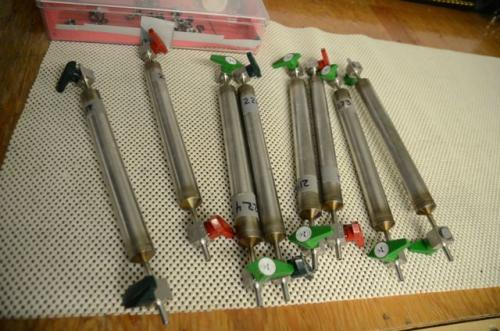
I cannot say much about what happens to the tritium samples, since some samples will be analyzed back at Lamont Doherty Earth ObservatoryA location used for observing terrestrial and/or celestial events. and others at Woods Hole Oceanographic Institution.
Helium samples, on the other hand, need more processing here on the ship before being sent back to those institutions. Anthony extracts the helium gas from the water sample and stores it in glass ampules. The principle for extraction method is simple increase helium's partial pressure in the water as much as possible and decrease its partial pressure above the water so the helium flows into the air (see March 22 for an explanation on partial pressure). Let us follow the hole process. Anthony first connects the sampling tubes to other stainless steel structure with more valves. The large cylinder on this structure is where the sample will be heated later on.
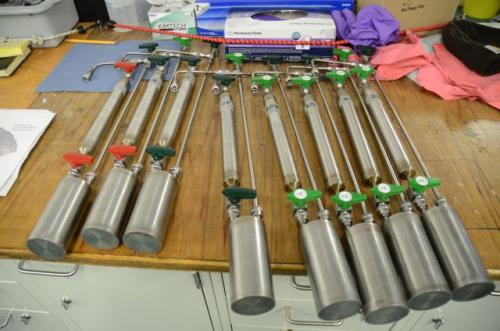
Anthony connects this larger structure to the extracting machine. The helium will end inside the glass bulbs that you see in the next picture.
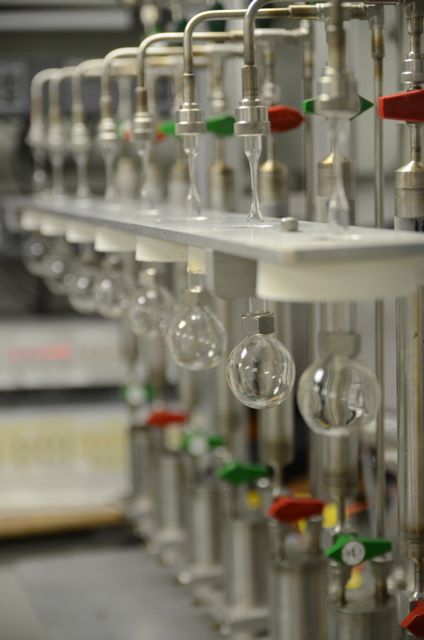
He places plastic cups with water an ice on the machine to give the glass bulbs an ice bath.

Anthony opens the valves and starts the pumps to create a vacuum on the tubes around the sample cylinder. He then closes the valves to the pumps and opens the valves of the cylinder. The water drains to the larger cylinder below the sampling tube where it is in a vacuum.
Having the sample in a vacuum (no air above it) means that the partial pressure of any gas is zero above the water. Anthony starts the electric heaters that are under the water sample to increase the partial pressure of the helium. The partial pressure of helium is now high on the water sample and zero above it, so the helium flows out of the water. Some of the water in the sample evaporates because it is hot and in a vacuum. The water vapor flows upwards and carries the heavier helium with it to the glass capsule in the ice bath.
The helium gets trapped inside the glass bulb. There is a narrow section of glass above the glass bulb where we can see the water vapor carrying the helium.
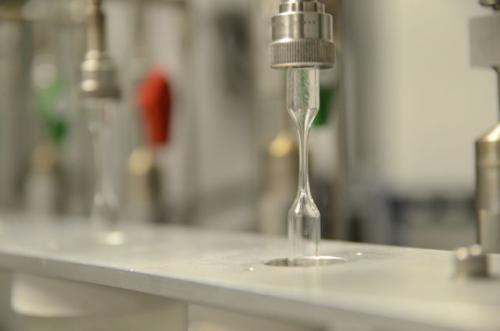
Anthony uses a torch to break the narrow section of glass and seals the upper part of the bulb turning it into an ampule. The helium and a small amount of water are enclosed in the glass ampule.
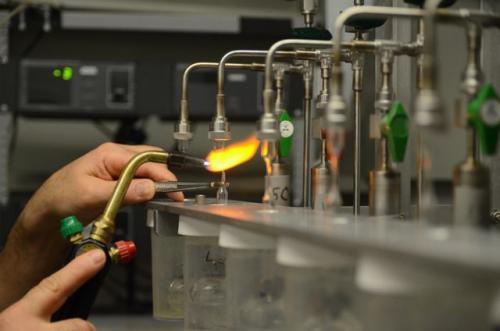
The ampules will be placed on a spectrometer back on land that will pierce the top of the ampule and measure the amount of helium in the sample. Anthony said that the tritium is left on its bottle to decay into helium fro about six months and will later be extracted in a similar way back home. Knowing how much tritium decayed in six months, and knowing that half of the sample decays in 12.5 years, a simple exponential equation tells them how much tritium was in the bottle at the beginning.This is a good method for estimating the age of a water mass (years since it was at the surface) that is about 60 years old when nuclear testing was being carried out. There are other methods for estimating the age of older waters.
Un cronómetro en el océano
Es hora de regresar al tema que dejé sin terminar hace casi un mes. ¿Cómo podemos calcular el tiempo que le toma a una masa de agua para moverse desde su lugar de origen?
Aquí un resumen de lo que hemos visto hasta ahora sobre masas de agua. Incluyo la fecha en la que escribí sobre el tema en caso de que no los hayas leído.
Las masas de agua son grandes volúmenes de agua con propiedades similares (temperatura, salinidad, gases disueltos, etc. [9 de marzo]
El agua adquiere sus propiedades casi siempre en la superficie del océano en donde intercambia energía y gases con la atmósfera, recibe energía del sol, y donde siente os efectos de la precipitación, evaporación, congelamiento y deshielo [9 de marzo]
El intercambio de gases entre la atmósfera y el océano depende del valor relativ de la presión parcial de ese gas en el agua y el aire [marzo 22]
Las aguas superficiales se hunden cuando se vuelven más densas que las aguas de alrededor [6 de marzo]
La densidad del agua marina depende de la temperatura, salinidad y presión. Algunas aguas superficiales en las zonas polares se vuelven meas densas en invierno cuando aguas de alrededor se congelan y liberan una salmuera muy fría [6 de marzo]
Podemos encontrar el origen de las masas de agua al analizar sus propiedades. De esta forma podemos hacer una estimación de la distancia que ha viajado el agua [9 de marzo].
Para poder predecir dónde se encontrará una masa de agua en el futuro necesitamos conocer la velocidad a la que se desplaza. Todos creemos saber lo que significa la velocidad: que tan rápido se mueve un objeto, pero la mayor parte de la gente se olvida de incluir la dirección en la que viaja el objeto en la definición de velocidad. Esta es la diferencia entre una cantidad escalar y una vectorial. La rapidez es un cantidad escalar ya que no incluye la dirección de movimiento; velocidad es la rapidez con dirección. Si quieres predecir en dónde estará un coche en 20 segundos necesitas saber que tan rápido se mueve pero también en que dirección. Otra forma de ver esto es dada por la diferencia entre tener un coche a 100 kilómetros por hora que viaja hacia un camión muy grande, o tenerlo a 100 kilómetros por hora viajando en dirección contraria al camión muy grande. El resultado es muy diferente en ambos casos aún cuando la rapidez del coche es la misma (yo no propongo que intentes este experimento).
Al analizar las propiedades del agua obtenemos la distancia y la dirección en la que se mueve el agua (la distancia y dirección forman el vector llamado desplazamiento). Sólo necesitamos conocer el tiempo que le tomó al agua cubrir esa distancia. ¿Cómo podemos obtener ese tiempo?
Los oceanólogos se dieron cuenta que el agua marina tiene incluido su cronómetro. El principio básico es identificar un gas atmosférico con las siguientes características:
1.Su concentración ene le aire cambia con el tiempo 2. Sabemos su concentración en el aire en diferentes tiempos. 3. La concentración del gas en el agua se mantiene constante on sabemos como cambia con el tiempo.
A los compuestos que satisfacen estas condiciones se les conoce como 'trazadores' (no te confundas con el término 'traza' cuando significa en muy bajas concentraciones como en 'metales traza').
Un ejemplo es el tritio, que es un isótopo del hidrógeno con dos neutrones (los isótopos son átomos del mismo elemento con diferente número de neutrones). Los humanos liberamos gran cantidad de tritio en los años cincuenta al realizar pruebas de armas nucleares. Sabemos la concentración de tritio atmosférico en diferentes años. El océano tomó parte de este tritio a traves de su superficie, el cual quedó atrapado cuando las aguas superficiales se hundieron. El tritio es radioactivo con una vida media de 12.5 años. Libera partículas ß (uno de sus neutrones se convierte en protón y electrón. El electrón sale disparado del átomo y el protón se queda en el núcleo) por lo que el tritio se convierte en hélio.
Nosotros medimos la cantidad de tritio y de hélio para estimar la concentración inicial de tritio en el agua. Los científicos necesitan estimar la cantidad inicial de tritio y encontrar la fecha en la que el aire tuvo la misma concentración. Con esto pueden estimar la fecha en la que esa masa de agua estuvo en superficie. Ingenioso, ¿no te parece?
Anthony Dachile esta a cargo del muestreo para medir hélio y tritio. Si tuviera que hacer una película con un laboratorio científico con máquinas de apariencia extraña y métodos raros escogería el de Anthony. Mientras el resto muestrea en botellas de vidrio, Anthony usa sofisticados tubos de acero inoxidable con válvulas y todo para las mediciones de hélio. Usa botellas de vidrio para las de tritio.

No puedo decirles mucho sobre el procesamiento de las muestras de tritio, ya que algunas muestras se analizarán en Lamont Doherty Earth Observatory y otras en Woods Hole Oceanographic Institution.
Las muestras de hélio, por otro lado, son parcialmente procesadas en el barco antes de mandarse a esas instituciones. Anthony extrae el hélio de las muestras de agua y lo almacena en pequeñas cápsulas de vidrio. El método de extracción se basa en un principio sencillo: aumentar la presión parcial del hélio en el agua y disminuirla al máximo sobre el agua para que el hélio fluya de agua al aire. (lee el diario del 22 de marzo para un explicación de la presi´øn parcial). Sigamos el proceso completo. Anthony primero conecta el tubo metálico de muestreo a una estructura de acero inoxidable más grande. El agua se calentará en el cilindro gordo en esta estructura.

Anthony conecta esta estructura a la máquina de extracción. El hélio acabará en los pequeños bulbos de vidrio que se ven en la siguiente foto.

Coloca unos vasitos de plástico con agua y hielo para darles un baño de agia fría a los bulbos de vidrio.

Anthony abre las válvulas y enciende la bomba de vacío para sacar todo el aire en el sistema de tubos alrededor de las muestras. Cierra estas válvulas y abre las del tubo de muestreo. El agua baja al cilindro gordo donde queda al vacío.
Al tener la muestra al vacío se logra que la presión parcial de cualquier gas es zero sobre el agua. Anthony calienta las muestras con un calentador eléctrico para aumentar la presión parcial del hélio. Con todo esto la presión parcial del hélio termina muy elevada en el agua y zero arriba del agua, por lo que el hélio fluye del agua al aire. Parte del agua de la muestra se evapora, ya que está caliente y al vacío. El vapor de agua acarrea el hélio que es más pesado hacia arriba hasta la bombilla de vidrio que está en baño de hielo.
El hélio queda atrapado en la bombilla, a cual tiene una sección muy delgada en la parte superior por donde se puede ver el vapor de agua.

Anthony utiliza una antorcha para romper el vidrio en su sección delgada y para sellar la bombilla en la que está el hielo convirtiéndola en una ampolleta. El hélio queda atrapado junto con un poco de agua.

La ampolleta se pondrá en un espectrómetro all llegar a tierra, el cual perforará la ampolleta en la parte superior y medirá la cantidad de hélio en la muestra. Anthony dijo que el tritio se deja en la botella unos seis meses a que decaiga a hélio, el cuál se extraerá de forma similar en los laboratorios de tierra. Sabiendo cuanto tritio decayó en seis meses, y sabiendo que la vida media del tritio es de 12.5 años, se puede saber caanto tritio había en la muestra con una sencilla ecuación exponencial. Este método es bueno para estimar la edad de masas de agua (años desde que dejó la superficie del mar) que son más jóvenes que 60 años, cuando se realizaron las pruebas nucleares. Hay otros métodos para estimar la edad de masas de agua más antiguas.


Comments